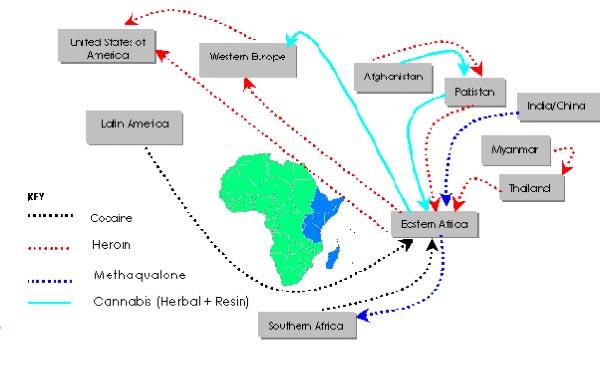Every day, vast quantities of illegal drugs crisscross the globe, weaving through complex and often hidden routes that law enforcement agencies tirelessly strive to intercept. But what makes tracing these drug trafficking routes such a daunting challenge? From shifting geography and sophisticated smuggling tactics to the ever-evolving technology at traffickers’ disposal, the puzzle is far from straightforward. Join me as we dive into the tangled web of drug trafficking networks and uncover the reasons why enforcement efforts often feel like chasing shadows.
Table of Contents
- Challenges in Mapping Complex Smuggling Networks
- The Role of Technology and Intelligence Gaps
- Why Geography and Politics Complicate Enforcement Efforts
- Innovative Strategies to Strengthen Border Security and Collaboration
- Final Thoughts
Challenges in Mapping Complex Smuggling Networks
Understanding the intricacies of drug trafficking networks is akin to piecing together a constantly shifting jigsaw puzzle. These organizations are experts at evolving their methods, creating a web that is deliberately designed to thwart detection. Their use of decentralized cells means that if one segment is compromised, others remain operational, making it painfully difficult for enforcement to dismantle the entire network. Additionally, traffickers exploit a diverse array of routes-from dense urban areas and remote rural paths to international waters and aerial corridors-each presenting unique obstacles to surveillance and interception.
Several factors complicate the mapping process, including:
- High levels of corruption that muddy lines of accountability and leak intelligence.
- Technological advancements such as encrypted communications and darknet marketplaces that conceal operations.
- The involvement of multiple countries with varied legal frameworks, which hampers cross-border cooperation.
- Constant shifts in trafficking patterns responding to law enforcement pressure, market demands, and geopolitical changes.
The interplay of these elements creates a labyrinth where tracking every link requires not just keen investigative skills but adaptive strategies and international collaboration, both of which remain ongoing challenges.
The Role of Technology and Intelligence Gaps
Advancements in technology have undeniably reshaped the landscape of drug enforcement, yet paradoxically, these same innovations often empower traffickers to stay one step ahead. Sophisticated communication tools, encrypted messaging apps, and the dark web create shadowy corridors where illicit deals flourish beyond the reach of conventional surveillance. Meanwhile, law enforcement agencies grapple with the challenge of integrating cutting-edge tech into their operations, often hindered by budget constraints, training gaps, and rapidly evolving criminal tactics.
Compounding the issue, intelligence gaps emerge as a critical obstacle, limiting the ability to map out precise trafficking routes. These gaps stem from a variety of hurdles, including:
- Fragmented data sharing between international agencies, which stalls coordinated responses;
- Underreported ground-level intel due to fear or corruption;
- Technological disparities in monitoring border regions and remote transit points;
- Rapid adaptation of traffickers moving their operations faster than enforcement can react.
Without a dynamic approach that harnesses both advanced technology and seamless intelligence collaboration, closing these crucial gaps remains an uphill battle in the fight against complex drug trafficking networks.
Why Geography and Politics Complicate Enforcement Efforts
When it comes to tracing drug trafficking routes, the intertwining of geographical barriers and political landscapes often creates a maze that law enforcement struggles to navigate. Vast mountain ranges, dense jungles, and sprawling coastlines act as natural shields, allowing traffickers to exploit hidden paths that technology and patrols often miss. Amid these physical challenges, traffickers adapt quickly, shifting routes and methods faster than traditional enforcement can respond. This constant cat-and-mouse dynamic drains resources and saps the momentum of anti-trafficking campaigns, making comprehensive monitoring nearly impossible.
Political factors add layers of complexity that amplify enforcement difficulties. Jurisdictional disputes, corruption, and unequal law enforcement capabilities across borders allow traffickers to find safe havens and exploit weak links in governance. Consider:
- Multiple sovereignties: Different countries enforce laws unevenly, creating loopholes that traffickers exploit.
- Conflict zones: Areas with ongoing political unrest provide cover zones that restrict access and surveillance.
- Diplomatic sensitivities: Cooperation can be hindered by diplomatic tensions, slowing down intelligence sharing and joint operations.
Such political quirks, combined with challenging terrain, create a tangled web that’s difficult to unravel – no wonder enforcement efforts often feel like trying to catch smoke with bare hands.
Innovative Strategies to Strengthen Border Security and Collaboration
To effectively dismantle the complex networks fueling drug trafficking, agencies must embrace cutting-edge technology alongside traditional tactics. Tools like AI-driven predictive analytics and real-time surveillance systems enhance the ability to anticipate and intercept suspicious activities before they escalate. On-ground, collaborative checkpoints equipped with biometric scanners, drones, and automated license plate readers create multiple layers of defense, ensuring coverage is both comprehensive and dynamic. This fusion of innovation and hands-on strategy allows enforcement teams to adapt swiftly to the traffickers’ ever-changing routes.
Successful collaboration across borders hinges on seamless information exchange and joint operational frameworks. When law enforcement entities in different countries synchronize efforts, share intelligence promptly, and coordinate raids, they significantly improve interception rates. Key elements include:
- Establishing secure, interoperable communication channels that prevent data silos
- Conducting regular cross-border training programs to align methodologies and build trust
- Implementing unified databases for tracking individuals and shipments linked to drug trafficking
These measures create a resilient network that can anticipate traffickers’ moves and respond with precision, pushing the limits of enforcement beyond traditional boundaries.
Final Thoughts
As we’ve seen, the labyrinth of drug trafficking routes is as complex as it is ever-changing, weaving through regions shaped by geography, politics, and economics. Enforcement agencies face a relentless challenge-not just because of the sheer scale of the networks, but due to the adaptability and resourcefulness of traffickers themselves. From shifting alliances to technological evasions, staying one step ahead is no easy feat. But understanding these hurdles better can spark fresh ideas and more effective strategies. So, what’s next in this ongoing battle? Only time, innovation, and a whole lot of persistence will tell. Stay curious-this story is far from over.












